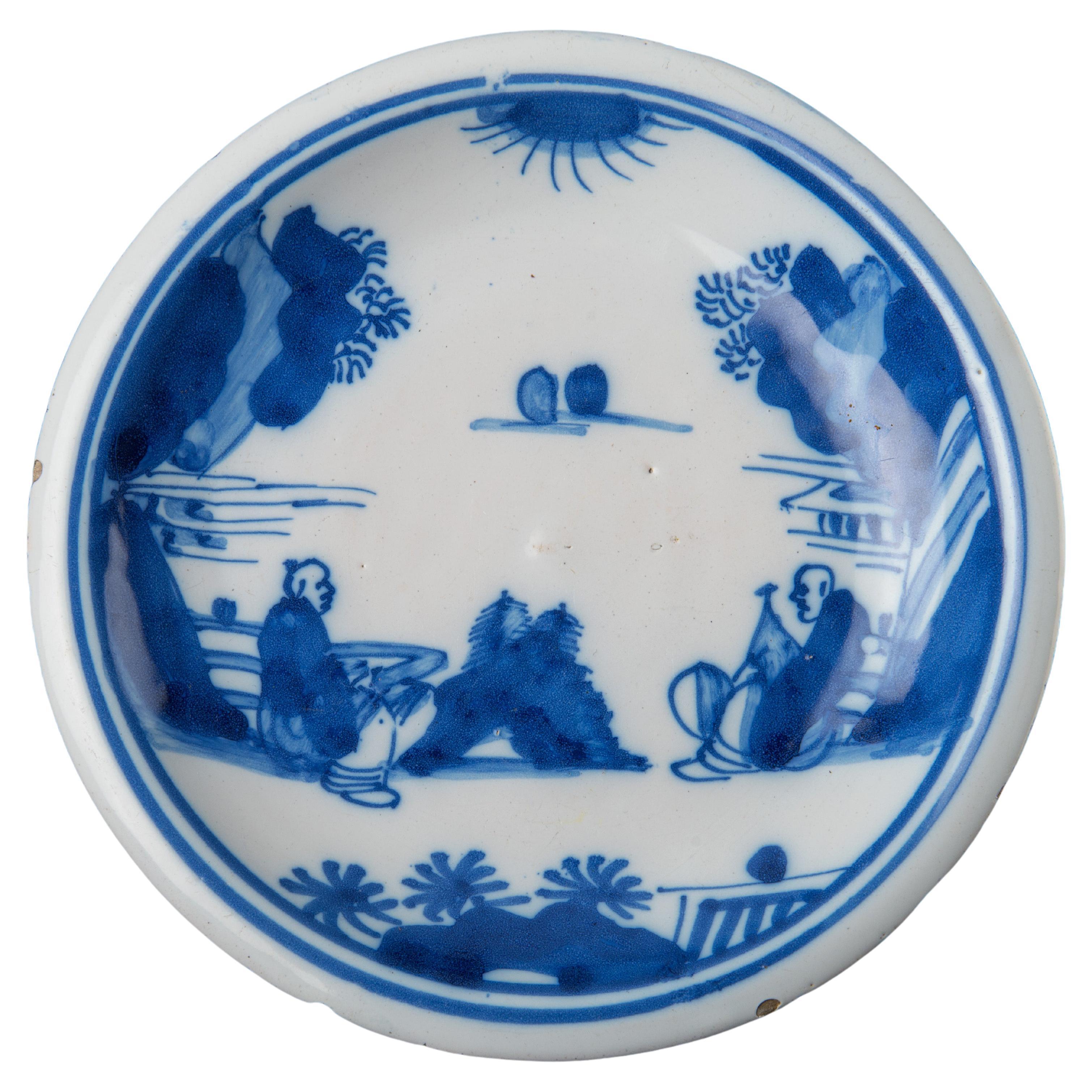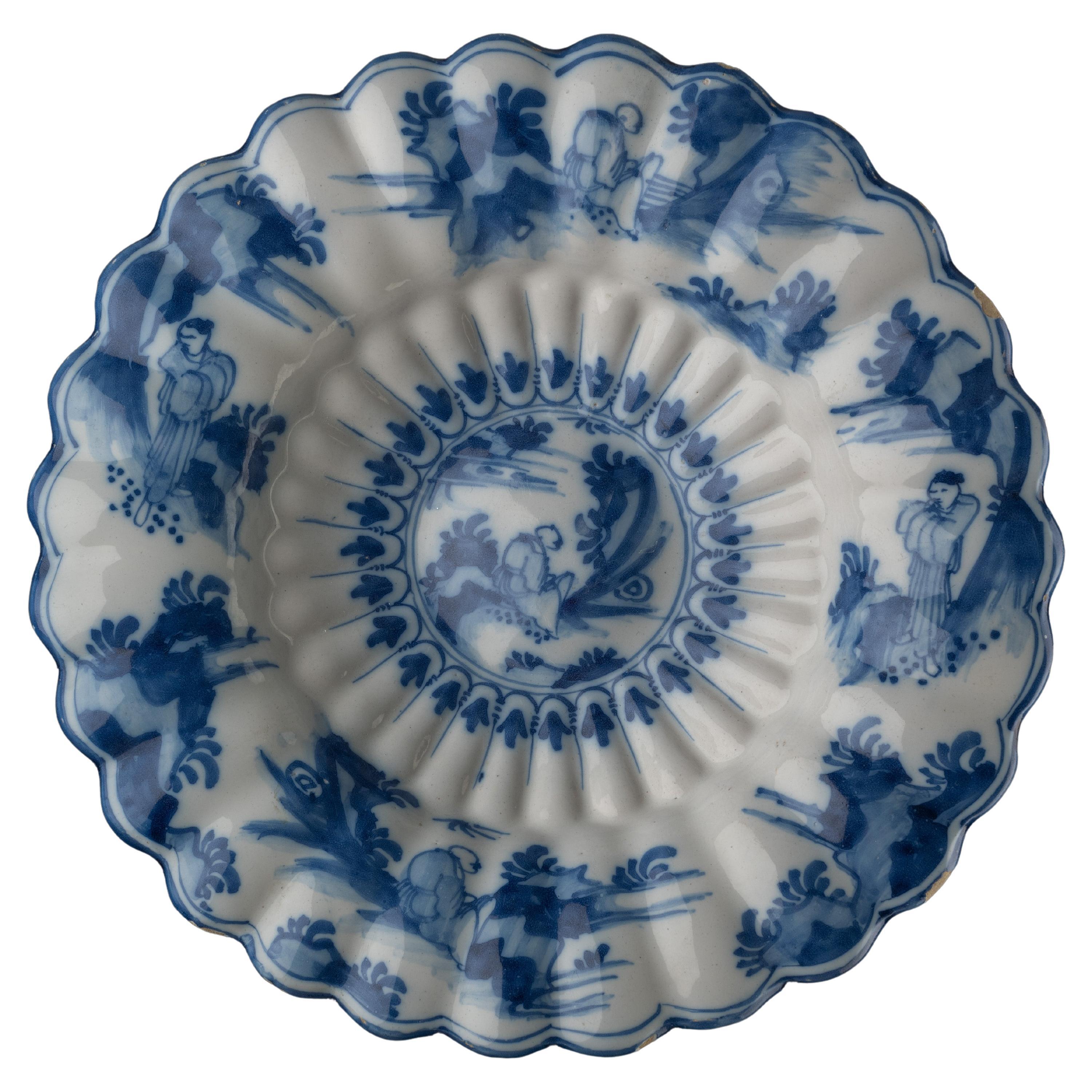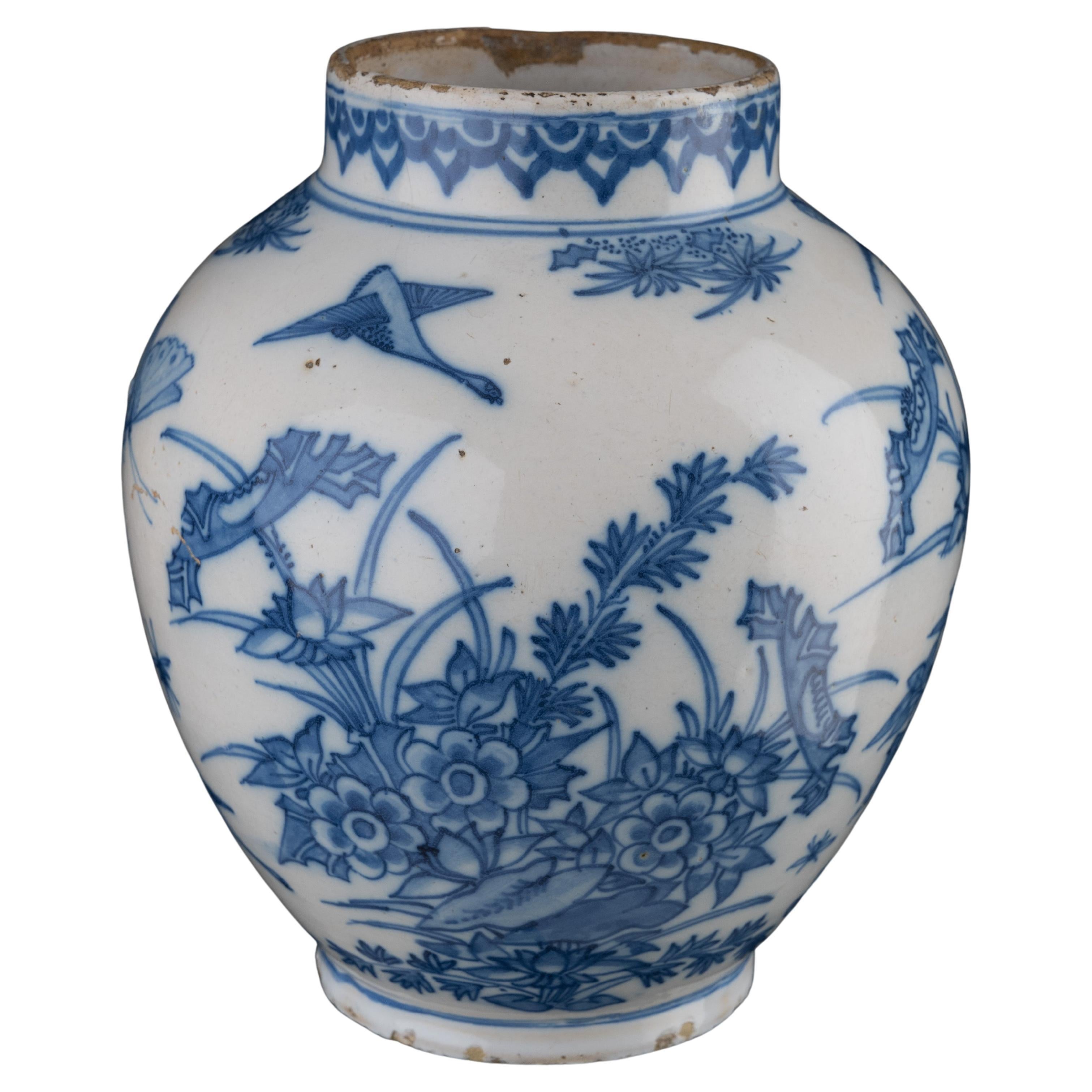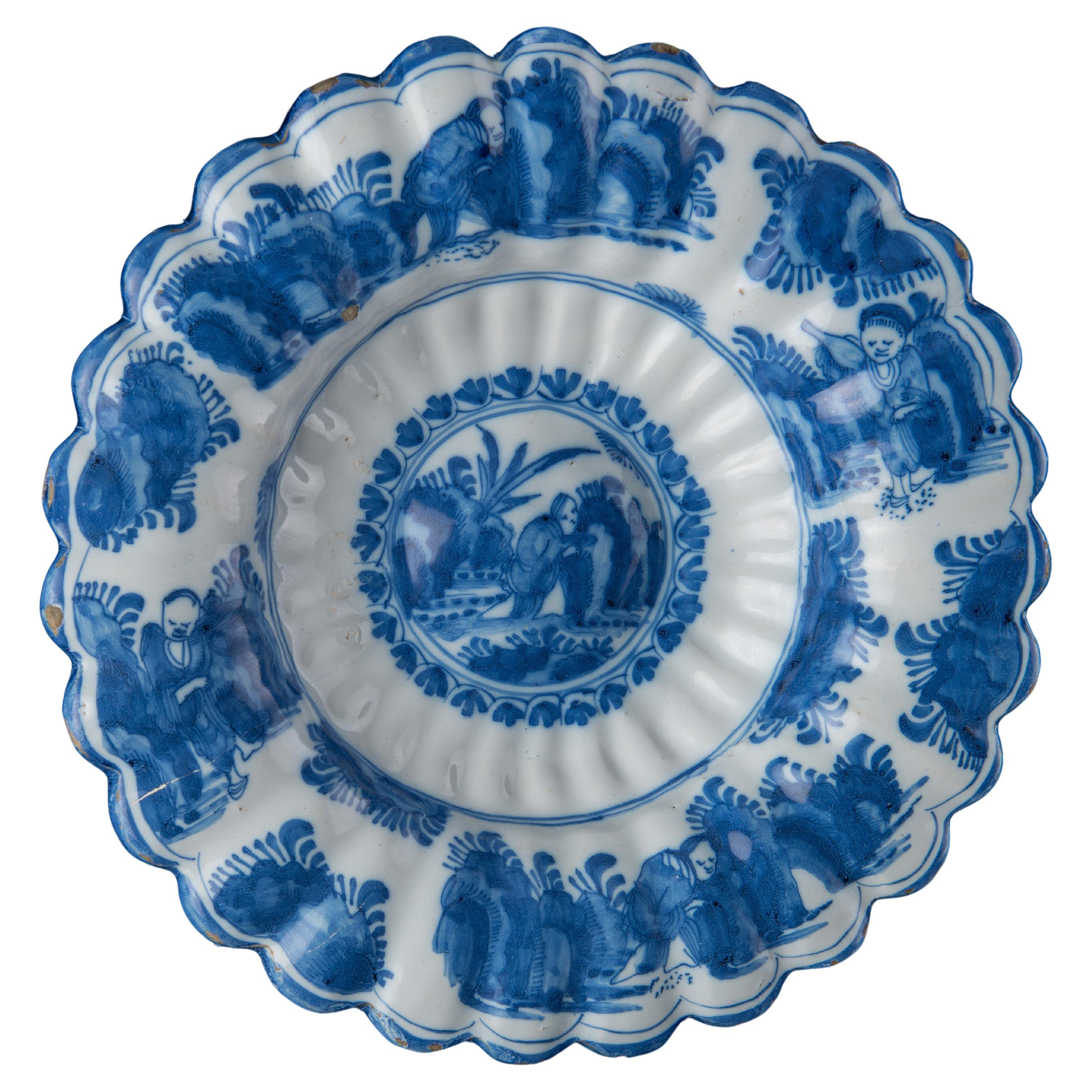Items Similar to Blue and White Chinoiserie Wine Jug Delft, 1650-1670
Video Loading
Want more images or videos?
Request additional images or videos from the seller
1 of 14
Blue and White Chinoiserie Wine Jug Delft, 1650-1670
About the Item
Blue and white chinoiserie wine jug Delft, 1650-1670
The ovoid-shaped wine jug stands on a waisted foot and has a slightly conical neck with a spout and an ear-shaped handle that ends in a rat tail. The top of the handle is pierced for a metal mount. The jug is painted in blue with two Chinese figures in an oriental rocky landscape. The shoulder is decorated with a band of scrolls and ornaments. The neck has two types of pointed ornaments, the handle with scrolls and stripes.
The decoration is inspired by Chinese porcelain from the transitional period at the end of the Ming and the start of the Qing dynasty. The porcelain of the last Ming emperor Chongzhen (reigned 1628-1644), the first Qing emperor Shunzi (reigned 1644-1662) and the initial period until 1674 of his successor Kangxi (reigned 1662-1722) may have served as examples for this dish. The transition period in China lasted more than 60 years (1620-1683) and was accompanied by much unrest, conflict and war. The Ming dynasty finally fell in 1644, but it took decades before peace returned to China. For example, the porcelain kilns in Jingdezhen, the main porcelain city in China, were destroyed in 1674.
Dimensions: height 22,7 cm / 8.93 in.
Condition: This jug is approximately 360 years old and in very good condition. There are the usual small glaze chips to base, opening and spout. There is also a larger glaze chip to top of handle.
- Creator:Dutch Originals (Maker)
- Dimensions:Height: 4.72 in (11.99 cm)Diameter: 8.94 in (22.71 cm)
- Style:Baroque (Of the Period)
- Materials and Techniques:
- Place of Origin:
- Period:Mid-17th Century
- Date of Manufacture:1660
- Condition:Wear consistent with age and use. Minor losses. There are the usual small glaze chips to base, opening and spout. There is also some glaze damages to top of handle.
- Seller Location:Verviers, BE
- Reference Number:1stDibs: LU1441225996932
About the Seller
4.9
Gold Seller
These expertly vetted sellers are highly rated and consistently exceed customer expectations.
Established in 2000
1stDibs seller since 2015
693 sales on 1stDibs
Typical response time: 2 hours
- ShippingRetrieving quote...Ships From: Velddriel, Netherlands
- Return PolicyA return for this item may be initiated within 3 days of delivery.
More From This SellerView All
- Blue and White Chinoiserie Plate, Delft, 1650-1670By DelftLocated in Verviers, BEBlue and white plate with a chinoiserie landscape with two sitting Chinese figures, within a double circle. The back of the plate is painted with the number 5, and the foot rim is pi...Category
Antique Late 17th Century Dutch Chinoiserie Ceramics
MaterialsCeramic, Faience
- Delft, Large Blue and White Chinoiserie Dish, 1670By Dutch OriginalsLocated in Verviers, BEBlue and white chinoiserie dish. Delft, circa 1670 Blue and white dish with a wide-spreading flange, the center painted with two conversin...Category
Antique Late 17th Century Dutch Baroque Delft and Faience
MaterialsCeramic, Faience
- Polychrome Chinoiserie Wine Jug, Delft, circa 1680By DelftLocated in Verviers, BEThe polychrome wine jug has an ovoid body on a low spreading foot, a conical neck with spout and a handle with a scroll finish. The jug is painted in purple, yellow and green with a continuous chinoiserie landscape with three Chinese figures. A band with scroll ornaments and circles is applied to the shoulder just below the neck, the neck itself is decorated with two stylized flowers and scroll ornaments. The handle is decorated with stripes and scroll ornaments. Dimensions: height 19 cm / 7.48 in. Multi-coloured chinoiserie landscapes on Delftware were only made for a short period of time, roughly between about 1680 and 1690. Most of the decors have been applied on dishes, lobed dishes, butter pots...Category
Antique Late 17th Century Dutch Baroque Ceramics
MaterialsCeramic
- Purple and Yellow Chinoiserie Wine Jug, Delft, circa 1680By DelftLocated in Verviers, BEPurple and yellow chinoiserie wine jug. Delft, circa 1680 The ovoid wine jug stands on a low spreading foot, has a conical neck with spout and a pewter mount and cover. The ear-shaped handle has a rat tail finish. The jug is painted in purple and yellow with a continuous chinoiserie landscape with three Chinese figures. A band with scroll ornaments is applied to the shoulder just below the neck, the neck itself is decorated with two types of stylized leaves. Another band with block ornaments is painted above the foot. The handle is decorated with stripes, dots and scroll ornaments. Dimensions: height 22 cm / 8.66 in. Multi-coloured chinoiserie landscapes on Delftware were only made for a short period of time, roughly between about 1680 and 1690. Most of the decors have been applied on dishes, lobed dishes, butter pots...Category
Antique Late 17th Century Dutch Baroque Ceramics
MaterialsCeramic
- Delft, Blue and White floral Chinoiserie Jar, 1650-1680By Dutch OriginalsLocated in Verviers, BEThe ovoid jar stands on a slightly spreading foot, has a short upright neck, and is painted in blue with a floral decor. Three large cartouches containing flower bouquets have been a...Category
Antique 17th Century Dutch Baroque Delft and Faience
MaterialsCeramic, Faience
- Polychrome Chinoiserie Wine Jug with Turned Body, Delft, circa 1680By DelftLocated in Verviers, BEPolychrome chinoiserie wine jug. Delft, circa 1680 The polychrome wine jug has an ovoid and turned body on a low spreading foot, a conical neck with spout and a handle with a scroll finish. The jug is painted in blue, purple and green with a continuous chinoiserie landscape with three Chinese figures. Bands with rectangular ornaments between double circles are applied on the shoulder and just above the foot. The neck is painted with a double leaf motif. The handle is decorated with stripes and scroll ornaments. Dimensions: height 23 cm / 9.05 in. Multi-coloured chinoiserie landscapes on Delftware were only made for a short period of time, roughly between about 1680 and 1690. Most of the decors have been applied on dishes, lobed dishes, butter pots...Category
Antique Late 17th Century Dutch Baroque Ceramics
MaterialsCeramic
You May Also Like
- Blue and White Chinoiserie Lobed Dish, Delft, 1650-1680By DelftLocated in ROSSUM, GEBlue and white chinoiserie lobed dish. Delft, 1650-1680 Dimensions: diameter 33,5 cm / 13.18 in. The blue and white lobed dish is composed of twenty-seven double lobes. The cur...Category
Antique Mid-17th Century Dutch Baroque Delft and Faience
MaterialsCeramic, Faience
- Blue and white floral chinoiserie jar Delft, 1650-1680By DelftLocated in ROSSUM, GEBlue and white floral chinoiserie jar. Delft, 1650-1680 The ovoid jar has a lightly spreading foot and a short, straight upright neck. The jar is p...Category
Antique 17th Century Dutch Baroque Ceramics
MaterialsCeramic, Faience
- Blue and White Chinoiserie Lobed Dish, Delft, 1650-1680By DelftLocated in ROSSUM, GEBlue and white chinoiserie lobed dish. Delft, 1650-1680 Dimensions: diameter 33,5 cm / 13.18 in. The blue and white lobed dish is composed of twenty-s...Category
Antique Mid-17th Century Dutch Baroque Delft and Faience
MaterialsCeramic, Faience
- Large Blue and White Chinoiserie Dish Delft, circa 1670 Chinese FiguresBy DelftLocated in ROSSUM, GEThe blue and white dish has a wide-spreading flange and is painted in the centre with two Chinese figures on a terrace by a pavilion in an oriental garden landscape. A third Chinese is visible in the background. The scene is framed in an octagon. The well and flange are divided into four wide and four narrow panels. The wide panels also feature oriental garden landscapes with one or two Chinese figures. The smaller panels are decorated with a stylised double flower. The outer rim is blue. The Victoria & Albert Museum in London has a similar, somewhat smaller dish . Several dishes with oriental landscapes and similar panelled borders can be found in a German private collection (Hebben & Peters, pp. 76-77), but instead of stylised flowers in the border, a floral scroll is applied here. The decoration is inspired by Chinese porcelain from the transitional period at the end of the Ming and the start of the Qing dynasty. The porcelain of the last Ming emperor Chongzhen (reigned 1628-1644), the first Qing emperor...Category
Antique 17th Century Dutch Baroque Ceramics
MaterialsCeramic, Faience
- Large Blue and White Chinoiserie Dish Delft, 1650-1680 Chinese FiguresBy DelftLocated in ROSSUM, GEThe blue and white dish has a wide, flat flange and is painted in the centre with two Chinese figures on a terrace in an oriental garden landscape. Two pavilions are visible in the background. The scene is framed in an octagon. The well and border are divided into four wide and four narrow panels. The wide panels feature oriental landscapes with a Chinese figure. The smaller panels are decorated with trellis work. The outer rim is blue. The decoration is inspired by Chinese porcelain from the transitional period at the end of the Ming and the start of the Qing dynasty. The porcelain of the last Ming emperor Chongzhen (reigned 1628-1644), the first Qing emperor...Category
Antique 17th Century Dutch Baroque Delft and Faience
MaterialsCeramic, Faience
- Early Delft Blue and white chinoiserie lobed dish The Netherlands, 1630-1650By DelftLocated in ROSSUM, GEBlue and white chinoiserie lobed dish The Netherlands, 1630-1650 The blue and white lobed dish is composed of twenty small lobes and is painted in the centre with a floral chinoiser...Category
Antique Late 17th Century Dutch Baroque Delft and Faience
MaterialsCeramic, Faience
Recently Viewed
View AllMore Ways To Browse
Dutch Kitchen
Dutch Decorated
Blue And White Foot
Dutch Baroque Furniture
Painted Wine Glasses
White Faience And Delft
Blue And White Oriental
Blue Jug
Chinoiserie Blue White
Blue And White Chinoiserie
Blue And White Faience Delft
Dutch Delft Blue And White
Small Jug
Small Jugs
White Jug
Dutch Blue Ceramics
Jug And Glasses Mid Century
Large Antique Jug





